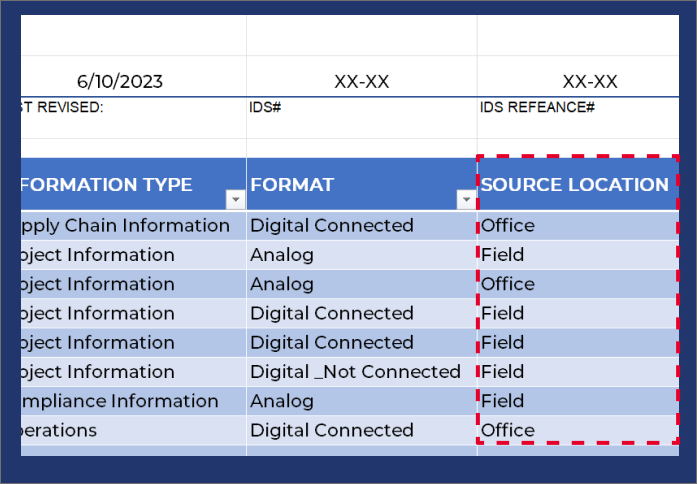Quality of Data
General
This field has a drop down for the parameters listed below. These represent commonly used parameter labels for data discovery but can be added to on the List Reference tab of the IDS.
Quality Of Data
 In this field, we are focusing on the importance of the quality of your data. High-quality data is accurate, reliable, and relevant, making it a valuable asset in decision-making and strategic planning processes. On the contrary, poor-quality data can lead to misguided decisions and misinformed strategies.
In this field, we are focusing on the importance of the quality of your data. High-quality data is accurate, reliable, and relevant, making it a valuable asset in decision-making and strategic planning processes. On the contrary, poor-quality data can lead to misguided decisions and misinformed strategies.
Data quality is one of the biggest challenges we will face in leveraging data within our organization. It is common for people to assume that their data quality is good or excellent and extremely common for people to trust digital information collected from within their own organization. That is why taking time and putting effort towards understanding the quality of your data is one of the most impactful parts of Data Stewardship.
In other sections we will discuss using data to help make critical decisions for our organizations. Those sections will concentrate more on the relevance of data, to the questions we are trying to answer but they will also refer back to this and other sections of the IDS. Sections like "Source Location” and “Generated By” can give insight into different aspects of data quality.
While determining quality can be complex. Its best to keep the categories simple to understand. The IDS uses just four categories.
Best Practices
- Poor- The data is incorrect, missing, or outdated.
- Fair- The data is mostly correct, but there are some issues with completeness or timeliness.
- Good- The data is correct and complete, but there may be minor issues with how current it is.
- Excellent- The data is correct, complete, and up-to-date.
Additional Quality Descriptions
- Accuracy- Data is correct, precise, and free of errors.
- Completeness- All necessary data is recorded and no data is missing.
- Consistency- Data is uniform and same parameters are used across all data sets.
- Timeliness- Data is up-to-date and available when needed.
- Relevance- Data is applicable and helpful for the purpose at hand.
Additional Information
When reviewing your data factors such as accuracy, completeness, consistency, timeliness, and relevance play critical roles in determining the quality of data. By understanding and monitoring these factors, your organization can ensure the integrity of its data, leading to more reliable analyses and outcomes. These additional categories can be added to the overall quality rating to give additional guidance to people reviewing the IDS, e.g.: Poor - Accuracy; Fair - Out of date.
Understanding Good Stewardship
 As stated in the beginning, people often make the assumption that if it's data-it's truth. Your job will often be to raise awareness around the quality of the data that people are relying upon. This can seem counter intuitive when you are also asking people to trust the data. So, it's important to be responsible in your criticisms and to not overstate or understate the reliability of the data that you're working with. Also, wherever possible refer to examples and physical reasons for inaccuracies to help those around you to form their own questions in regards to data quality.
As stated in the beginning, people often make the assumption that if it's data-it's truth. Your job will often be to raise awareness around the quality of the data that people are relying upon. This can seem counter intuitive when you are also asking people to trust the data. So, it's important to be responsible in your criticisms and to not overstate or understate the reliability of the data that you're working with. Also, wherever possible refer to examples and physical reasons for inaccuracies to help those around you to form their own questions in regards to data quality.

